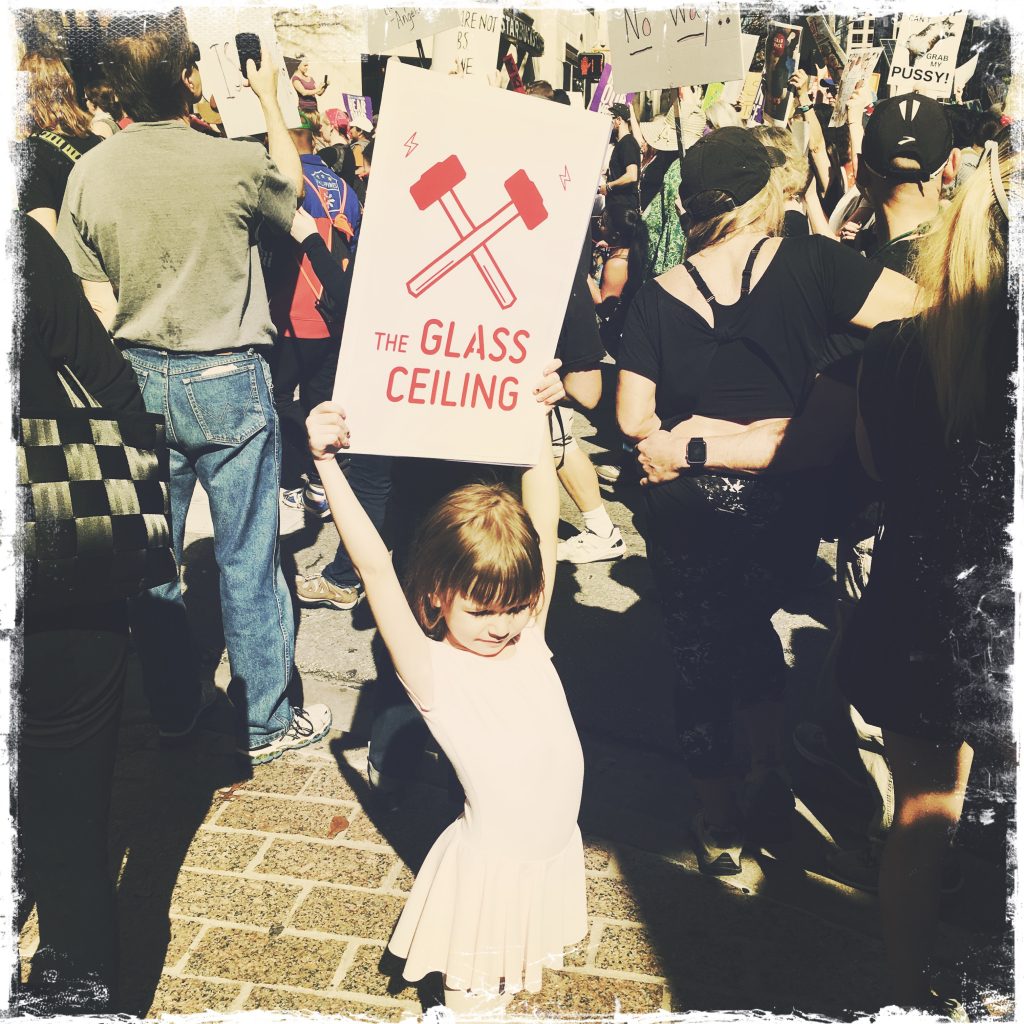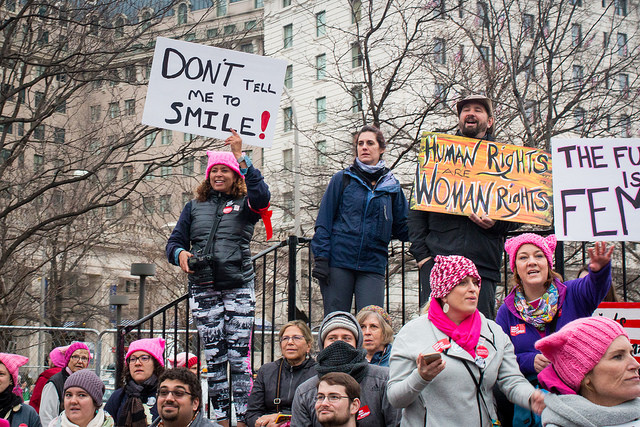A recent Saturday morning in Austin started with coffee and breakfast tacos with friends, followed by a walk downtown to join more friends at the March for Science. Many of us, including my four-year-old daughter, were carrying signs with witty slogans. Others were pushing strollers, and some had prepared by reading things like the online Activist Mama’s Guide to Taking Kids to a March. Singing, chanting, pointing to people dressed in white lab coats and Star Trek costumes, or carrying large periodic tables, chatting with strangers similarly equipped with babies, strollers, and signs — the mood was joyful, even if the issues the march addressed, such as climate change or infectious disease research, could not have been more weighty. Anger at the Trump administration, while hardly absent, did not set the tone. Instead, we celebrated the righteousness of our positions and our feeling of strength in numbers. It was 70 degrees and sunny: even the weather was on our side.
Other Austin demonstrations since Inauguration Day — the Women’s March on January 21, the Tax Day March, the Climate March — produced a similar emotional climate. The same, as has been remarked over and over, has by-and-large been true of anti-Trump protests all across America in the last few months (with the notable exception of events at “Patriots Day” free speech rally in Berkeley on April 17, which, rather than a confrontation between pro- and anti-Trump voters, should rather be considered as a clash between anti-fascists versus white nationalists). The commitment to positivity, the feeling of empowerment, and the expression of solidarity with marginalized groups have been dominant themes in the discourse around these events, which have seemed to offer a spectacular rebuke to the public rage and hate-mongering so evident in Donald Trump’s campaign rallies.
Protests do not just take place on the streets. Photos of witty signs posted on Twitter, Facebook, or Instagram have been integral parts of these public events. I shot many pictures of our group and of the signs carried by my fellow protesters at a recent March for Science in Austin, Tex.: “The Earth doesn’t have 4 years,” “Less Invasions More Equations,” “You can’t comb over racism,” “Science is not a liberal conspiracy,” “Can’t Build A Wall, Hands Too Small,” and “Pussy Not Up For Grabs,” to name just a few.
Strangers kept asking me if they could photograph my daughter with her sign “Make America Think Again.” Under normal circumstances, the idea of a stranger wanting a picture of my daughter might seem creepy, but in the context of the march it felt benevolent, and I agreed without hesitation. Images taken by others that showed up on my Facebook feed reinforced the mood of joy, a merging of online and physical participation. They also served as encouragement for others to join in.

It is hardly news, of course, that social media and cell phone cameras are driving new modes of community life and political engagement. It is worth paying attention, however, to the image of protest in Trump’s America. The formal qualities of the photos and the scenes they depict stand in marked contrast to the history of protest photography, and to recent photos of dissent taking place in a different context.
Documentary photo-journalism has created a familiar legacy of protest imagery: Selma, Kent State, the occupied West Bank, Arab Spring, Gezi Park, all the way down to the Black Lives Matter protests that began in 2014. Iconic images as Ceyda Sungur, wearing a red dress, being pepper-sprayed by police in Turkey in 2013, or Iesha L Evans standing still in the face of two Louisiana state troopers in 2016, cast the vulnerability of unarmed protesters against the solid frame of uniformed authority. Their composition is usually vibrant and forceful. Multiple dark elements (silhouettes of policemen, crowds of protesters, anti-riot gear) give the image a sharp, graphic character. Over and over, what these photos offer is an image of protest as a dramatic, often violent contest over the rights of civilians to occupy public space — a contest in which protesters must put their own bodies on the line.
By contrast, the images that have come from the anti-Trump marches show the viewer that the right to assemble and protest in public is simply assumed, never contested, and the threat or reality of violence is entirely absent. Rather than demonstrators bloodied by bullets, or hurling rocks and gasoline bombs, we see peaceful, politically articulate acts of resistance by people moving freely in urban public space, equipped with artful, often witty, banners, pussy hats, Starbucks lattes, and — of course — cameras. Instead of intense shots of clashing bodies, we get evenly-lit, amateurishly composed images documenting an almost leisurely, festival-like episode of dissent. Children are often present in these images, while threatening lines of cops in riot apparel are nowhere to be seen. We sometimes see selfies taken with grinning policemen, posing patiently and dealing out high-fives. The visual celebration of protest as an act of joyful unity and even reconciliation between citizens and the state was taken to absurd heights in the commercial featuring Kendall Jenner partying her way through a crowd of marchers and sparking an eruption of joy when she offers a Pepsi to a police officer.
Even if the Pepsi commercial met with almost universal derision, there is no question that the spirit that it tried to capture — to the point of self-parody — can be recognized in the images we ourselves have been making and sharing recently. These images of activism infused with joy and affirmation are captivating — they become odd family albums.
By picturing public protest as a matter of the joyful and peaceful exercise of an uncontested right, these social media images valorize a form of political action that is underwritten by white privilege. Scarce images like the one of Angela Peoples, a black co-director of the LGBTQ equality organization, carrying a sign that read “White Women Voted for Trump” at the Women’s March on Washington against the backdrop of three white women in pink hats taking selfies, are uncomfortable reminder that only some can laugh and affirm their way out of dark political status quo.

As was evident in the marches that followed the killing of Michael Brown in Ferguson, Missouri, in 2014, African-American protesters cannot rely on the same opportunity to peacefully claim public space — just as they have not been able to in decades past, just as others at the margins of American society have not been able to. For all the chants of “Black Lives Matter” (along with “Trans Lives,” “Muslim Lives” and so on) at various anti-Trump rallies, genuine solidarity may require acts of political engagement which are not conducive to joy—whether it is offering protection to undocumented immigrants by disrupting ICE raids, shielding women seeking access to a Planned Parenthood clinic from abuse by anti-abortion campaigners, or joining a Black Lives Matter protest the next time a police officer kills an unarmed African-American person. It may not be wise to bring your children along when participating in such actions. Confrontation with the police or with political opponents is possible. And emotions such as rage, grief, disgust, frustration, shame and fear, which do not photograph so well — but which a long lineage of feminist and queer thinkers and activists (Audre Lorde, Betty Friedan, bell hooks, Sara Ahmed) have insisted can be driving forces of political dissent — may come to the surface.
These other feelings are present in images that spark resistance. Shaky and raw, they are taken surreptitiously, like a disturbing footage of police killings of Tamir Rice, Terence Crutcher or Philando Castile’s, and many other names that have become a hashtag. They may be taken by others as an act of control and surveillance, as in case of Sandra Bland. They turn into bewildered, helpless onlookers.
The conditions that have made it possible to organize peaceful, even joyful, demonstrations this spring cannot be taken for granted. The authoritarian tendencies of the Trump administration are plain to see and have certainly not been ignored by the media. Less attention has been given to actions by state and local governments that erode civil liberties, including the right to peaceful protest. I have no doubt that the spirit of resistance that has animated the recent marches has staying power, and that there will be many more marches on weekends to come. I plan to take part in them. But I wonder what will happen when such demonstrations become less joyful, when the police are less friendly. What will happen when marches are no longer occasions for posting group shots of smiling kids and friends on Facebook? Will we keep our nerve — or will we fade away?


